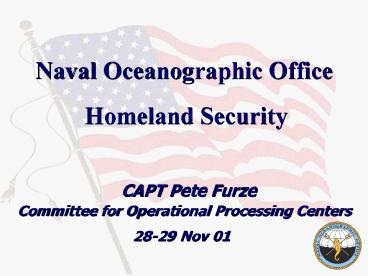Naval Oceanographic Office PowerPoint PPT Presentation
1 / 13
Title: Naval Oceanographic Office
1
Naval Oceanographic Office
- Homeland Security
- CAPT Pete Furze
- 28-29 Nov 01
Committee for Operational Processing Centers
2
Greetings from COPC
to COPC
3
HOMELAND SECURITY OCEANOGRAPHIC COORDINATION
MEETING
- NAVOCEANO hosted meeting on 15-16 October
- Participants
- - Naval Oceanographic Office (NAVOCEANO)
- - National Oceanic Atmospheric Administration
(NOAA) National Ocean Service (NOS) - - NOAA National Environmental Satellite and Data
and Information Service (NESDIS) - - U.S. Army Corps of Engineers/Vicksburg
- Focus
- - Communication
- - Collaboration
- - Efficiency
4
HOMELAND SECURITY OCEANOGRAPHIC COORDINATION
MEETING
- Discussed collaborative approaches to
ocean-related Homeland Security issues. - Protection of
- - Waterways
- - Ports
- - Maritime transportation
- Three principal areas of discussion
- - Collaborative Survey Operations
- - Ocean Modeling Instrumentation
- - Data Networking, Processing Storage
5
HOMELAND SECURITY OCEANOGRAPICCOORDINATION
MEETING
- Working Groups formed in each of the following
areas - 1. Collaborative Survey Operations
- -- Mine Countermeasures
- -- Maritime Domain Awareness
- 2. Modeling and Instrumentation
- 3. Data Networking, Processing and Storage
6
HOMELAND SECURITY OCEANOGRAPHICCOORDINATION
MEETING
- Collaborative Survey Operations Working Group
- Tasks
- Define the actual MCM port collection
requirements. - Navy and NOAA to resolve consolidated port list
and priorities with Coast Guard input. Coast
Guard will coordinate with civil and commercial
port authorities. - Define MCM maintenance requirements and develop a
resource plan. - Develop operational plan for baseline route
surveys.
7
HOMELAND SECURITY OCEANOGRAPHICCOORDINATION
MEETING
Collaborative Survey Operations Working Group
Accomplishments
- Held meeting 14 Nov. in Wash, D.C. USACE, NOAA,
NAVOCEANO, CINCLANTFLT, COMMINEWARCOM, Canadian
Navy, and EOD Mobile Unit 7 attended to exchange
initial survey technical issues and discuss
near-term collaborative survey plans. - Conducting collaborative survey operations in
Kings Bay, GA. - Next meeting 11 Dec. to plan joint Norfolk
survey.
8
HOMELAND SECURITY OCEANOGRAPICCOORDINATION
MEETING
- Modeling and Instrumentation Working Group
- NAVOCEANO will organize a workshop to consider
coordination of physical modeling and data needs
for Homeland Security to - (1) Share information on operational and
quasi-operational physical models for
currents, water level, and pollution transport. - (2) Discuss continuing approaches to
- - Inventory, coordination, and centralized
dissemination of model output. - - Share model code and outputs.
- - Compare among model outputs and
observations for model validation - - Share technical capabilities (e.g. data
assimilation techniques). - (3) Define RD requirements needed to transition
priority models in geographic areas.
Tasks
9
HOMELAND SECURITY OCEANOGRAPHICCOORDINATION
MEETING
Modeling and Instrumentation Working Group
Accomplishments
- Developed and disseminated Model Inventory
template to partners in modeling community.
Responses have started coming in. - Planning workshop to be held at NAVO 29-30 Nov.
Approximately 20 senior technical representatives
will attend from NOAA, USACE, EPA, NAVO, NRL, and
others. - Objectives of the workshop include
- - Options for national coordination for
hydrodynamic contaminant fate modeling for 50
ports. - - Data requirements to support the above
modeling. - - Data Networking requirements for real-time data
and model product dissemination. - - Inventory of existing model implementations and
supporting data.
10
HOMELAND SECURITY OCEANOGRAPHICCOORDINATION
MEETING
- Data Networking, Processing, Storage Working
Group - Tasks
- (1) Address classification level for this
Homeland Security effort.
Recommend Unclassified - (2) Address coordinated contingency response.
- (3) Interact with customer base (new) to define
custom products. - (4) All agencies will press their RD communities
to determine what applied science can be rapidly
transitioned to an operational capability. - (5) Establish Points of Contact and working
groups to - - Coordinate common hydrographic data formats,
product deliverables, and contractual support. - - Coordinate interagency data processing,
networking, and storage efforts. - - Navy and NOAA to discuss collaborative ENC
co-production and maintenance efforts. - - Navy and NOAA to discuss MCM related processing
and production.
11
HOMELAND SECURITY OCEANOGRAPHICCOORDINATION
MEETING
Data Networking, Processing, Storage Working
Group
Accomplishments
- Held introductory meeting at National Coastal
Data Development Center (NCCDC) on 22 October to
establish working relationship. - Held technical meeting at NCDDC 31 October.
- Pending NCDDC visit to NAVOCEANO for technical
details. - Full meeting of WG to occur 28 -29 November.
- Agenda items include
- Briefings on Core Capabilities
- Perspectives on GIS
- Classification of effort
- Coordinated contingency response.
- Product Definition
- Emergent RD
- Data Formats
- Required contractual support
- Collaborative relegation of processing,
networking, storage
12
Navy Operational Oceanography
(1) Formed Crisis Action Team (CAT) to plan
Homeland Security Actions. (2) Provide 24/7
operational support for Homeland Security. (3)
Provide Daily/Weekly Intel briefs for SSC
agencies. (4) Implement CONUS circulation model
(8 km) to provide boundary conditions for higher
resolution nested models. (5) Conducting
collaborative CONUS port survey ops, including
Q-routes. (6) Providing 3 ships, HSLs, AUV and
personnel for Homeland Security surveys. (7)
Sharing U.S. port data with National Partners.
13
Questions?

